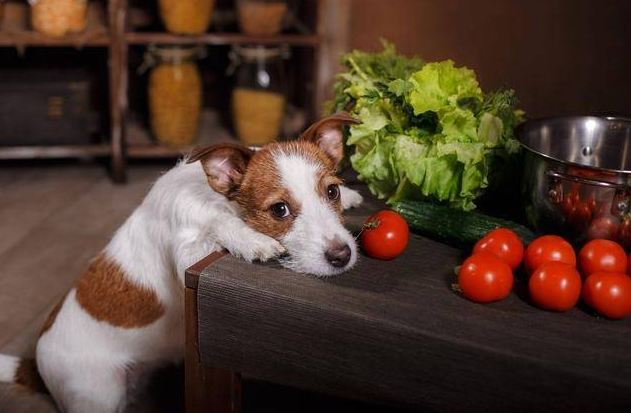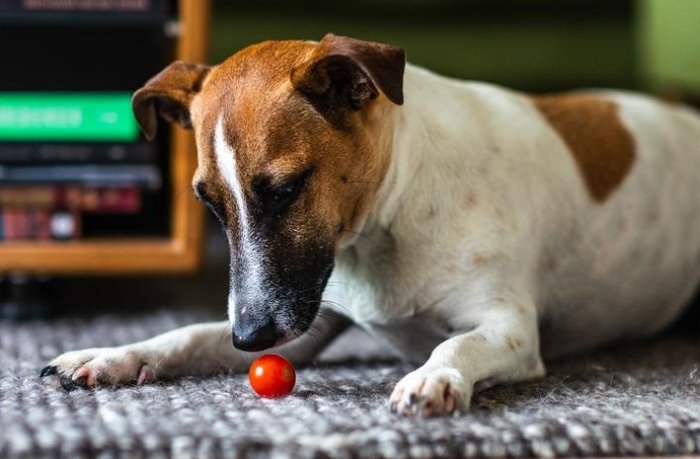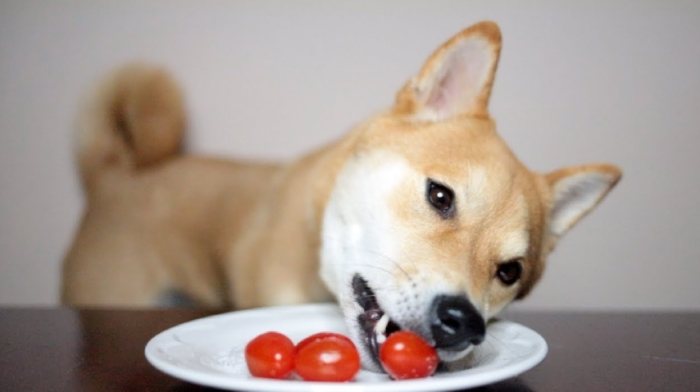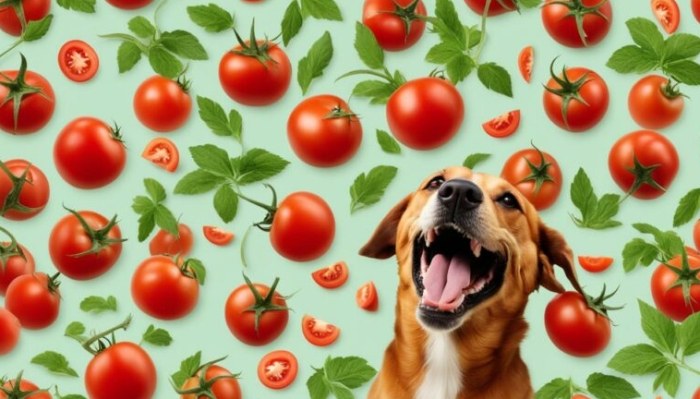Advertisements
Can Dogs Eat Tomatoes? Safety, Poisoning Signs, Feeding Tips & Serving Sizes
Can dogs eat tomatoes? Discover if tomatoes are good for dogs, signs of tomato poisoning, and how to safely feed them. Learn the right amount of tomato to give your dog and whether tomato paste is safe.
Table of contents
- Can Dogs Eat Tomatoes? The Basics
- Signs of Tomato Poisoning in Dogs: When to Panic (When to Calm Down)
- Are tomatoes good for dogs? Nutrition Facts
- How many tomatoes to feed your dog? A guide
- Can Dogs Eat Ketchup? The Processed Tomato Debate
- Q&A: Popular questions about dogs and tomatoes
- Final Thoughts: Tomatoes or Not?
Can Dogs Eat Tomatoes? The Basics
Ah, that million-dollar question. Can Dogs Eat Tomatoes? In short: It’s complicated. Tomatoes belong to the Solanaceae (aka nightshade), a family that also includes potatoes, eggplant, and—you guessed it—toxic plants like belladonna. Here’s what’s going on:
The Good, the Bad, and the Stemmy
-
**Ripe tomatoes (red): Generally safe for dogs to eat in moderation. They’re low in calories and packed with nutrients like lycopene (an antioxidant) and vitamin C.
-
Unripe tomatoes (green): High in solanine, a toxic compound that can upset your dog's system.
-
Stems, leaves, and vines: Stay away from them. These parts are high in solanine and can cause serious problems.
Here's the thing: Yes, dogs can eat ripe tomatoes, but be careful. Always remove the stems, leaves, and any green parts before slicing them for your dog.
But wait—what breed is my dog?
Some breeds, like collies, are more sensitive to solanine than others. Australian shepherds and border collies, for example, react more strongly to plants in the nightshade family. If your dog has a sensitive stomach or a history of food intolerances, it's best not to give him tomatoes.
Real-life scenario: My dog ate a tomato—now what?
Imagine this: You're chopping vegetables for dinner, and within two seconds of turning your back, — crunch — your Labrador is munching on the tomato you dropped. First, don't panic. If it's a small, ripe piece of tomato, they should be fine. But if it's green, or if they've eaten the stem of a tomato, watch for symptoms of tomato poisoning (more on that later).
Signs of Tomato Poisoning in Dogs: When to Panic (When to Calm Down)
Okay, let's talk about toxicity. Solanine poisoning from tomatoes isn't common, but it does happen. Here are some things to watch for if your dog strays into a tomato patch:
Early Warning Signs
-
GI Upset: Vomiting, diarrhea, or excessive drooling.
-
Lethargy: Your normally active pup suddenly becomes lazy.
-
Loss of Appetite: They're turning up their noses at their favorite foods.
Red Flags (Call the Vet ASAP)
-
Tremors or Seizures: Solanine affects the nervous system.
-
Weakness or Collapse: This is a big problem—don't wait.
-
Confused or Disoriented: If your dog seems "unconscious," it's time to take action.
How Many Tomatoes Are Too Many?
A lick of ketchup or a bite of a ripe tomato slice probably isn’t a problem. But if your dog eats a whole unripe tomato or a few stems, things could be dangerous. Signs of tomato poisoning in dogs usually appear 6-12 hours after ingestion, so keep a close eye on them.
My dog ate a tomato plant – what should I do?
If your pup decides to decorate your garden with tomato vines, don’t wait until symptoms appear. Call your veterinarian or the American Society for the Prevention of Cruelty to Animals (ASPCA) Animal Poison Control Center (888-426-4435) immediately. They’ll instruct you whether to induce vomiting or take your dog to the hospital for treatment.
Are tomatoes good for dogs? Nutrition Facts
Okay, tomatoes are not poisonous* (*when ripe and cooked safely). But are they really good for dogs? Let’s break it down.
Health Benefits
-
Lycopene: An antioxidant that may help reduce inflammation and protect against certain cancers.
-
Vitamin C: Boosts the immune system and supports skin health.
-
Fiber: Aids digestion (but only in small amounts—too much can have the opposite effect).
Cons
-
Acidity: Tomatoes are acidic and can irritate sensitive stomachs or trigger acid reflux.
-
Solanine Risk: Even ripe tomatoes contain trace amounts of solanine, so moderation is key.
-
Allergies: Some dogs are allergic to tomatoes (it's rare, but possible). Watch for itching, hives, or swelling after eating them.
Are tomatoes good for dogs with specific medical conditions?
-
Dogs with pancreatitis: Probably not. The acidic nature may irritate the pancreas.
-
Dogs with kidney problems: Don't eat them. Tomatoes are high in oxalates, which can aggravate kidney stones.
-
Overweight pups: A small piece as a snack? Sure. But don’t count on tomatoes for weight loss—they’re not a magic bullet.
How to Safely Feed Tomatoes to Dogs: A Step-by-Step Guide
Okay, you’re on board with the idea of sharing tomatoes with your pup. Here’s how to do it right.
Step 1: Choose the Right Tomatoes
-
Ripe and Red: No green spots, please.
-
Organic (if possible): Fewer pesticides = safer for your dog.
-
Medium-sized: Cherry tomatoes are cute, but can be a choking hazard for pups.
Step 2: Prepare Like a Pro
-
Wash Thoroughly: Even organic tomatoes can contain dirt or pesticides.
-
Remove stems, leaves, and vines: These are the toxic parts—no exceptions.
-
Cut into small pieces: For small dogs, cut tomatoes into quarters. For large dogs, cut in half.
Step 3: Introduce Slowly
-
Start with a small piece: For small dogs, pea-sized; for large dogs, blueberry-sized.
-
Wait 24 hours: Watch your dog for signs of tomato toxicity (vomiting, diarrhea, etc.).
-
Gradually increase: If all goes well, you can offer a slightly larger piece next time.
Step 4: Blend Safely
-
Bake into a treat: Try this simple recipe: blend mashed ripe tomatoes with plain yogurt and freeze in ice cube trays.
-
As a topping: Add a small piece to kibble for a nutritional boost.
-
Avoid processed tomatoes: Avoid tomato sauce, ketchup, or canned tomatoes with added salt or spices.

How many tomatoes to feed your dog? A guide
Now, let's talk numbers. How many tomatoes to give your dog? Depends on their size, diet, and tolerance. Here are rough guidelines:
By Dog Size
| Dog Size | Safe Serving Size | Frequency |
|---|---|---|
| Toy (5-10 lbs) | 1-2 small cherry tomatoes, quartered | Once a week |
| Small (10-25 lbs) | Half a Roma tomato, sliced | Once a week |
| Medium (25-50 lbs) | 1 small tomato, sliced | Twice a week |
| Large (50+ lbs) | 1-2 medium tomatoes, sliced | Twice a week |
Signs You're Overdoing It
-
Loose stools: Reduce immediately.
-
Excessive thirst: Tomatoes act as a diuretic, so overfeeding them can cause dehydration in puppies.
-
Behavioral changes: If your dog seems "unwell" after eating a tomato, stop feeding it.
What about puppies?
Puppies have sensitive stomachs, so wait until they are at least 6 months old before giving them tomatoes. Even at 6 months old, start with a small piece and monitor closely.
Can Dogs Eat Ketchup? The Processed Tomato Debate
Ah, the old question: Can Dogs Eat Ketchup? Short answer: No. Here’s why:
The Problem with Processed Tomatoes
-
Added Salt: Most ketchup contains sodium, which can cause dehydration or sodium ion poisoning in dogs.
-
Spices and Herbs: Garlic, onions, and oregano are common in ketchup—all toxic to dogs.
-
Concentrated Solanine: Even if the sauce is made from ripe tomatoes, the processing increases the solanine content.
When is Ketchup OK to Eat?
-
If it’s homemade and unsalted: You could theoretically take a lick, but why bother? Fresh tomatoes are much safer.
-
As a rare treat: Maybe if you're making homemade dog-friendly pizza (yes, it's a thing), but stick to spreading no larger than a dime.
Ketchup alternatives
-
Pumpkin puree: Low in calories, high in fiber.
-
Purple banana puree: A sweet, dog-safe treat.
-
Plain yogurt: Adds creaminess, but without the risk.
Q&A: Popular questions about dogs and tomatoes
Let's quickly answer those questions you're too embarrassed to ask your vet.
Can dogs eat tomatoes with the skin on?
Yes, but remove the stem and any green parts first. Tomato skin is theoretically safe, but some dogs have trouble digesting it. If your dog gets an upset stomach after eating the skin, peel it off next time.
What happens if a dog eats a little tomato?
Probably nothing. A small slice of a ripe tomato is unlikely to cause harm. But if the tomato is unripe, or if your dog eats the stem, watch for signs of tomato poisoning (vomiting, diarrhea, etc.).
Can Dogs Eat Grape Tomatoes?
Yes, but it’s best to cut them into quarters to prevent your puppy from choking. Grape tomatoes are smaller than regular tomatoes, so they’re a little more risky for puppies.
Final Thoughts: Tomatoes or Not?
Here’s the thing: Dogs can eat tomatoes, but tomatoes aren’t a necessity in their diet. If your dog loves tomatoes and is well-adjusted to them, give them a slice once in a while. But if they’re a picky eater or have a sensitive stomach, skip the tomatoes and stick to dog-safe vegetables like carrots or green beans.
Remember: Safety first, don’t get too hung up on the freshness. Signs of tomato poisoning in dogs are no joke, so proceed with caution. If you have any questions, call your vet right away—they’d rather get a ton of “Is this safe?” calls than treat a sick pup.
Leave a Message